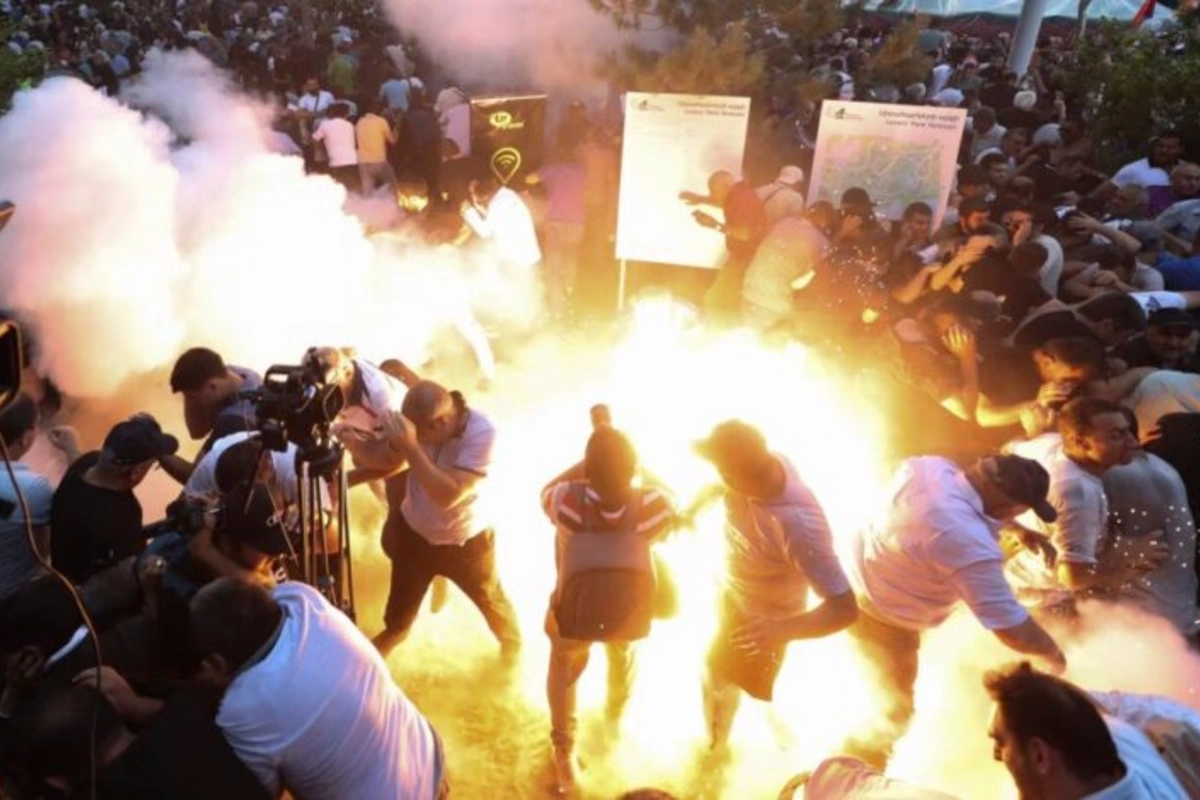
Baku and Yerevan continue to work on delimiting the Azerbaijan-Armenia border, an essential step towards lasting peace in the South Caucasus. But some Armenians are deeply unhappy about the process.
Image: turanews.kz
Just over six years ago, Armenia’s Prime Minister Nikol Pashinyan was swept to power in mass street protests that ousted his predecessor, Serzh Sargsyan. Last week it seemed that the tables might be turning as around 3500 demonstrators blockaded the Armenian National Assembly demanding Pashinyan’s resignation. The June 12 protest was the latest in a series of demonstrations opposing the delimitation and demarcation of the Armenia-Azerbaijan border inspired up by Tavush for the Motherland group. They had started out on May 4 with a 160km march to Yerevan from the village of Kirantz in Armenia’s northeastern Tavush region (hence the name), the place where the first significant agreement on delimitation of (legally agreeing) any Azerbaijani-Armenian border sector had been made in mid-April.
The march, led by Archbishop Bagrat Galstanyan, arrived in Yerevan on May 9 and demonstrations have continued ever since. Until recently things had remained largely peaceful. However, tensions flared during a June 12 standoff outside parliament that occurred as the prime minister addressed assembled deputies inside. Over 100 people were injured, including 18 police officers, making it the largest instance of political violence since Pashinyan came to power. The government claims that protestors had attempted to breach police lines while supporters of the Tavush for the Motherland movement allege the disproportionate use of force, including the heavy-handed use of stun grenades.
In a statement issued the following day, the U.S. Embassy in Armenia urged protestors to eschew violence while encouraging law enforcement to maintain order in such a way that still allowed citizens their right freedom of assembly. It also called on the authorities to investigate any incidents in which standard procedures might have been violated including those that involved journalists. International human rights and media watchdogs have made similar calls.
Meanwhile Pashinyan maintains that the police acted “legally and professionally” to “defend Armenia’s statehood.” He has also accused the opposition of paying demonstrators 5,000 Armenian Drams (approximately $13) each to participate in protests, referring to those behind the movement as a “clerical-feudal clan.”
The government continues to accuse Karekin II (the Catholicos of All Armenians), along with former President Robert Kocharyan, and his ‘Dashnak’[1] allies of masterminding Galstanyan’s movement. Archbishop Galstanyan has been involved with other Dashnak-led protests seeking to depose Pashinyan since early 2022 and observers claim that he would have had to seek the approval of the Catholicos before doing so.
Last weekend, Galstanyan sat side by side with Ara Abrahamyan, a prominent ally of Russian Vladimir Putin, at a conference largely attended by Russian-Armenians as well as members of Kocharyan’s opposition parliamentary faction. Abrahamyan last year also called for the intervention of the Russian military in Armenia. Both the protest and the conference came in the same week as U.S. Deputy Assistant Secretary of State for European and Eurasian Affairs James O’Brien arrived in Yerevan for strategic partnership talks with Foreign Minister Ararat Mirzoyan.
For now, the 12 June demonstration seems to have failed to achieve its objectives, and over the weekend, the government raided the ARF-D detaining over a dozen people.
Opposition deputies had managed to table a resolution to discuss the “government's resignation and the formation of a new government” in an extraordinary session to be held five days later. However, from the outset, Pashinyan’s ruling Civil Contract party made it clear that they would not attend the debate, intended to deprive the opposition of a quorum to discuss the matter. On 17 June, as Galstanyan amassed around 4000 people outside, government deputies boycotted the session and the tactic worked.
Dashnaktsutyun MP Artsvik Minasyan accused the government of “attempting to overthrow the constitutional order” while Galstanyan criticized non-governmental organisations and political actors that chose not to condemn the government’s actions. But perhaps in a sign that his movement has now exhausted itself, he also stated that it would be “reformed” as internal “discussions continue.” He plans to tour the country to build support outside of the capital.
Also touring the regions this weekend was Pashinyan. Visiting the southern-most Siunik region, he met with residents of several villages on the Armenia-Azerbaijan border there. Showing them photographs of the newly erected fence on the now demarcated part of the Tavush-Gazakh section of the border, he explained why the process is so important for local communities, including for farmers who currently keep sub-optimal heads of livestock in fear that with too many, some could stray into Azerbaijan.
“The Government should continue to widely inform the people about what is happening” Pashinyan told media. People must know “why it is happening, what is its purpose, what are the complications, what are the risks, what are our tools and methods to manage the risks, and we should continue to move forward with that logic.”
These comments naturally led to speculation that Siunik could be the next location for border delimitation as commissions finalise the regulations governing their work (expected by 1 July). Addressing the possibility, Pashinyan was un-committal to the region but underlined that the job would continue.
[1] the nationalist Armenian Revolutionary Federation – Dashnaktsutyun (ARF-D), often abbreviated to ‘Dashnak’), has been part of Kocharyan’s Armenia Alliance grouping since 2021.
Share on social media